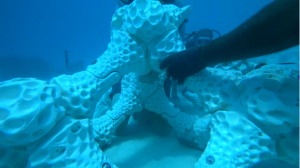World’s Largest 3D Printed Coral Reef Now Resides in the Maldives
Coral reefs are important not only to the millions of species that live in them, but to humans as well. Reefs protect coastlines from storm surges during violent storms, and they also offer a great deal of income from tourism and fishing. Coral reefs are in quite a bit of trouble at the moment, though. 50 percent of the world’s reefs have died in the last 30 years, and 90 percent of the surviving reefs may die off in the next century if action isn’t taken to save them. The reefs are suffering from numerous threats – climate change, overfishing, damage from boats, and other human-caused damage.
 Humans may be responsible for threatening the coral reefs, but many humans are also taking responsibility for saving and restoring them. 3D printing has been found to be an effective way of creating artificial coral reefs, which are then dropped into the ocean where it’s hoped, free-floating coral polyps will attach themselves to them and grow into new coral structures. That coral will then attract the fish and other species that make their homes in reefs, and a new, natural reef will grow from the artificial seed material.
Humans may be responsible for threatening the coral reefs, but many humans are also taking responsibility for saving and restoring them. 3D printing has been found to be an effective way of creating artificial coral reefs, which are then dropped into the ocean where it’s hoped, free-floating coral polyps will attach themselves to them and grow into new coral structures. That coral will then attract the fish and other species that make their homes in reefs, and a new, natural reef will grow from the artificial seed material.
Several reefs have already been 3D printed and sunk into the ocean, and now Reef Design Lab, an Australian organization dedicated to the creation of artificial reefs, has created what, it turns out, is the largest 3D printed artificial coral reef so far. 3D molds of the reef structures were 3D printed over 24 hours, then used to cast the structures in ceramic, which is similar to the calcium carbonate found in actual coral reefs. The 3D printed molds were printed in Australia and shipped to the Maldives, filled with concrete, assembled at Summer Island and then dropped into the ocean, where they now rest seven meters below the surface.
Live coral was then transplanted into the artificial reef, where it will hopefully grow and colonize the artificial structure, forming a new, living reef.
“3D printing technology helps us to develop more innovative ways of protecting coral reefs. The technology allows us to mimic the complexity of natural reef structures, so we can design artificial reefs that closely resemble those found in nature,” said Alex Goad of Reef Design Lab. “We hope this will be a more effective way of growing and restoring corals.”
The creation of artificial reefs isn’t new – humans have utilized sunken ships and concrete blocks to attract coral in the past. 3D printing, however, allows for the natural structure of coral reefs to be imitated, which attracts more marine life. In this case, Goad used CAD to design replicas of naturally-occurring coral reef structures before 3D printing them. The complex shapes of natural reefs are difficult to create in any other way, so 3D printing has become a valuable asset in the creation of these reefs.
It will take several years for coral and the other species that make reefs their home to populate the artificial structures, so we won’t know for some time if these 3D printed experiments are truly working. They show a lot of promise, though, and for the 25% of marine species that depend on coral, help can’t come soon enough. Scientists are hoping that the Summer Island reef will be covered in coral within the next two years, and if the project succeeds, more will likely follow.
“Projects like the 3D printed reef are popular among guests, who like that we protect our environment,” said Mari Shareef, Manager of the nearby Summer Island Resort. “And it’s not only for the guests. Our staff, most of whom are Maldivian, want to protect their environment. “Ultimately, we want to help promote a culture of environmental stewardship, not just at Summer Island, but across the Maldives.”
Discuss this and other 3D printing topics at 3DPrintBoard.com or share your thoughts below.
[Source: Verdict/Images: Reef Design Lab]Subscribe to Our Email Newsletter
Stay up-to-date on all the latest news from the 3D printing industry and receive information and offers from third party vendors.
Print Services
Upload your 3D Models and get them printed quickly and efficiently.
You May Also Like
Rob Higby: How Continuum’s Scrap-to-Powder Model Caught Siemens’ Attention
Continuum Powders has spent over a decade working on a bold idea: why mine new metal when high-quality material is already flowing through today’s factories as scrap? Now, thanks to...
Nano Dimension Evaluates Desktop Metal Post-Takeover, Completes Acquisition of Markforged
For the latest updates (as of April 25, 2025), see the end of this article. A Delaware court recently forced Nano Dimension (Nasdaq: NNDM) to finalize its long-delayed acquisition of...
Jason Lopes, Gentle Giant CTO and Hollywood Trailblazer, Honored at AMUG 2025
At this year’s Additive Manufacturing Users Group (AMUG) conference in Michigan, one name stood out: Jason Lopes, chief technology officer (CTO) of Gentle Giant Studios. Known for pioneering 3D scanning...
RAPID 2025: Stratasys & trinckle Announce Strategic Software Partnership
News continues to flood in from last week’s RAPID+TCT 2025, including a new partnership between AM market leader Stratasys and Berlin-based software company trinckle. By automating important steps in fixture...































